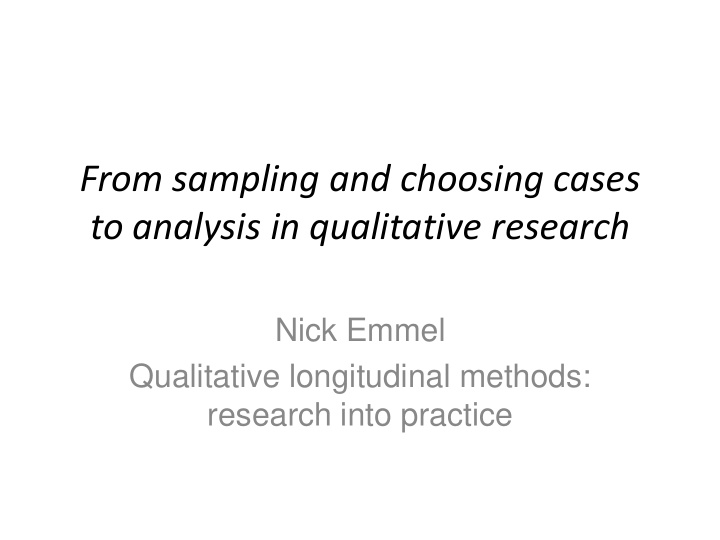



From sampling and choosing cases to analysis in qualitative research Nick Emmel Qualitative longitudinal methods: research into practice
Overview • Our qualitative longitudinal studies (1999 and ongoing) in a geographically bounded low-income social housing estate. Our focus are the core poor and their accounts of the texture of poverty through the investigation of various aspects of their lives — growing up, grand parenting, relationships with service providers and others on the estate, access to health services, and their relationship to wider social, economic, and political events and processes In this presentation I will consider — • A very brief introduction to the generative mechanisms of sampling and casing in qualitative research • Time and sampling — life histories and multiple interactions • Some methodological reflections • Some ethical considerations
The generative mechanism of sampling (cf. Pawson and Tilley, 1997) • Sampling is purposively directed and re-cast through the research towards the purpose of testing and refining theory through the sum of intellectual work done in developing research questions about the social world. • Sampling is purposefully strategic in its search for information rich cases to be strategically compared. • Sampling is theoretically framed because we generate data, do analysis, and discover / refine theory interactively in the research, which necessarily includes positioning our sampling within contextual accounts, we therefore extend our cases (Burroway, 2009) The short and long shadows of sampling in qualitative research
Casing: a methodology, not something we study The ‘5 Cs’ of choosing cases, a casing methodology: • Control — organising • Characterising — looking for attributes and relationships • Conciliation — reconciling • Collegiality — making theoretical choices explicit • Contextualising — bounding units (Emmel and Hughes, 2009; Emmel, 2012 — forthcoming)
Making time explicit in sampling — life histories • A theoretical lead — ‘the past is reconstituted in the present…each moment is recreated, reselected and evoked afresh in the light of new knowledge…the past is revocable and as hypothetical as the future’ (Adam, 1990:143) • Implications for sampling — we can not make sense of the life histories we choose, without explicitly sampling (and therefore accounting for) the context within which they are spoken.
Micro-context (within the accounts)The death of Billy In Sheila interview 1 (RMP:32) • ‘We threw him out, and we’re better off without ‘ im. Good riddance to that’ In Sheila interview 1 (TS:14) • ‘It's, erm... I just call him a silly old bloody bugger, me. He could've stopped at any... He should've stopped. He did. He should’ve done, he should've stopped cos, to me, he'd got eight kids, he'd got grandkids, he should of stopped, he'd of been around for his grandkids and kids then. And now he's not gonna be there when [Richard’s ] new one comes along. And... Oh I don't know. I still don’t know how I feel about him passing on. Probably cos I didn’t see him that much either, so if, if I pretend he's not, you know, if I don’t think about it I just pretend he's sat at his mother’s on t’sofa , you know, a bit like [David] does. Erm... Yeah, I don't, I don't know how I feel about it.’
Macro-context (beyond the accounts) — the political-economy of recession ‘Recession, it’s all the same to us son’ (see Emmel and Hughes, 2010) Interview Bob and Diane (January, 2008) ‘ We’re all fucked son!’ Recorded conversation with Bob (December, 2010)
Some methodological considerations • Avoiding attrition – Negotiating a long-term relationship at the outset – Intermittent funding / different researchers – Demonstrating the impact of the research – Maintaining contact and a relationship • Dealing with attrition – Casing and maintaining a temporal account in the on- going refining of theory, they are not withdrawn from the study – The account of why they have left the study is often very useful, if it can be obtained
• Adding participants (sample boosting) – To follow theoretical leads and answer questions – The value of ‘being there’ and relationships of trust in access – Snowballing, sampling along a network – In our research we wonder if we are moving from sample to population
Some ethical considerations • On-going consent, the negotiation and re- negotiation of consent in the research • Consent for secondary analysis in the research team and by other researchers • Reflecting back on Sheila’s and her children’s reworking of their relationship with Billy, how do we use accounts that have been revoked? • Maintaining contact – respecting privacy – how hard can we try if a participant does not respond to our calls / letters?
n.d.emmel@leeds.ac.uk Nick Emmel (2012 forthcoming) Sampling and choosing cases in qualitative research. London. Sage.
References • Adam B (1990). Time and social theory . Cambridge: Polity Press. • Burawoy M (2009). The extended case method and one theoretical tradition . Los Angeles: University of California Press. • Emmel N, & Hughes K (2010). 'Recession, it's all the same to us son': the longitudinal experience (1999-2010) of deprivation. 21st Century Society , 5 (2), 171-182. • Emmel N, & Hughes K (2009). Small N access cases to refine theories of social exclusion and access to socially excluded individuals and groups. In Byrne D, & Ragin C (Eds.), The Sage Handbook of Case-Based Methods London: Sage. • Pawson R, & Tilley N (2000). Realistic Evaluation . London: Sage.
Recommend
More recommend